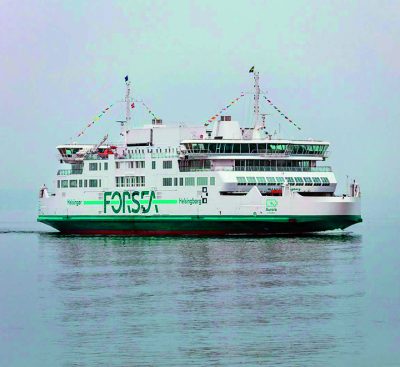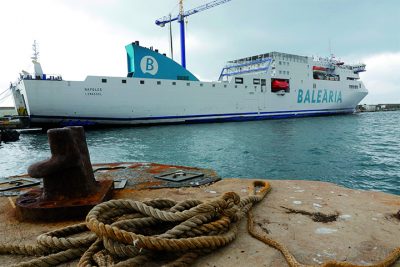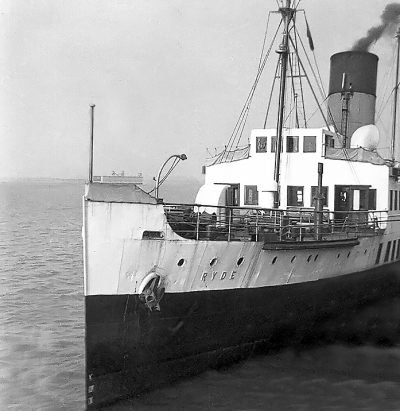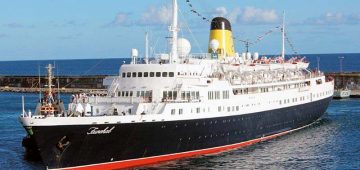New Look for Western Channel Operator

On 20th November Brittany Ferries revealed that it is adding a splash of colour to its ships, with a bright new logo in shades of blue, orange and green. The new design, which comes with a more modaern, warm and lyrical typeface, will be applied to each ship during their respective refits, and will eventually be emblazoned on the side of every vessel’s hull and funnel. The logo is the result of extensive customer research and is designed to reflect travel by sea, the welcome ashore and on board, and the spirit of discovery. The new visual identity comes as part of a multi-million-Euro investment to make Brittany Ferries fit for the future. Three brand new ships are currently under construction and due to join the fleet in 2019, 2021 and 2022. A wide-ranging digital transformation programme is also underway, aimed at enhancing every aspect of the customer experience from researching to booking, checking-in, sailing, holidaying and returning home. The new design was first glimpsed by eagle-eyed photographers at the shipyards where the 29,468gt/2009 built Armorique and 40,859gt/2004 built Pont-Aven (above) were undergoing winter refits in November. Throughout 2019 the new look will be rolled out across all Brittany Ferries sites, marketing and operations including everything from signs, brochures, uniforms, to advertising and websites.
Third E-Flexer Underway
On 27th November Stena Line confirmed that the first three E-Flexer Ro-Pax ferries ordered for service on the Irish Sea are all now under construction following the steel cutting ceremony for the third vessel. The trio of ships is scheduled to enter service in 2020 and 2021 and each ferry is being built at the Avic Weihai Shipyard in China. The first of the 215m long and 3,100 lanemetre/120 car/1,000 passenger capacity newbuilds will commence operation on the Holyhead-Dublin route in early 2020, with the remaining two ships to be introduced on the Liverpool-Belfast route in 2020 and 2021. In addition, Stena Line has also ordered a further two E-Flexers with larger dimensions (240m long/3,600 lanemetre/1,200 passenger capacity) to be deployed within Stena Line’s network in 2022. The first E-Flexer is due to be floated out on 16th January. The fourth ship in the series will reportedly be destined to become Brittany Ferries’ Galicia. The ferry operator chartered Seatruck’s 7,606gt/1998 built Clipper Ranger from 18th November for a week as a short-term solution to cover for the 13,017gt/1996 built Stena Hibernia on the Belfast-Heysham route. The ‘Ranger used to serve this route for Seatruck and the ‘Hibernia had been suffering from mechanical issues for a few days prior. Meanwhile, sold out of the fleet have been the two Swedish-flagged Stena 4-Runner Mk II Class Ro-Ro ships, namely the 24,688gt/2001 built Stena Foreteller and the 24,688gt/2003 built Stena Forecaster, to undisclosed Buyers. As from 26th December 26th, Stena Line’s 64,039gt/2010 built Stena Britannica and Stena Hollandica will switch schedules on the Hoek van Holland-Harwich route for 2019 with the ‘Britannica operating the daytime sailing from Hook van Holland and the ‘Hollandica likewise from Harwich. The 24,206gt/2000 built Stena Nordica will return to the Irish Sea in early 2019 to cover for refits on the Cairnryan, Birkenhead and Fishguard services.
World Firsts for Autonomy
At the end of November, Wärtsilä successfully completed test procedures of its autonomous shipping system using the ferry Folgefonn for a full dock-to-dock autonomous operation on the route, calling at all three ports. This was believed to be the first ever attempt at a fully automated dock-to-dock operation, in complete hands-off mode, for a vessel of this size. The 1,182gt/1998 built and 85m long Folgefonn is owned by Norwegian ferry operator Norled. She was used also for the initial testing of the Wärtsilä autodocking solution, which took place in the early part of 2018. The vessel is equipped with hybrid propulsion and features numerous other Wärtsilä innovations, including its wireless inductive battery charging solution and energy storage systems. Shortly after this, Rolls-Royce and Finnish state-owned ferry operator Finferries demonstrated what was described as the world’s first fully autonomous ferry in the archipelago south of the city of Turku, Finland. The 53.8m long and 517gt/1993 built double-ended car ferry Falco used a combination of Rolls-Royce Ship Intelligence technologies to navigate autonomously during her voyage between Parainen and Nauvo at the beginning of December. The return journey was conducted under remote control. During the demonstration, the ship, with 80 invited VIP guests aboard, conducted the voyage under fully autonomous control and detected objects utilising sensor fusion, artificial intelligence and conducted collision avoidance. The ability to berth automatically with a recently developed autonomous navigation system was also demonstrated. All this was achieved without any human intervention from the crew. Prior to the demonstration, the vessel had accrued close to 400 hours of sea trials. Earlier in 2018, Rolls-Royce and Finferries began collaborating on a new research project called Safer Vessel with Autonomous Navigation (SVAN) to continue implementing the findings from the earlier Advanced Autonomous Waterborne Applications (AAWA) research project, funded by Business Finland. Things come in threes and the above two trials were quickly followed by ABB’s remote-control trial using an electric ferry from Helsinki to Suomenlinna fortress, about 20 minutes by boat from the Finnish capital. In what ABB said is a world first for autonomous passenger ferries, the trial has demonstrated the potential for operating sea-going vessels without the need for an on-board human operator. The ferry used is fitted out with ABB’s specially designed Azipod electric propulsion system and the autonomous trial was conducted outside normal operating hours and without passengers on board, with the ship’s captain, Lasse Heinonen, conducting the remote operations from Helsinki harbour using ABB’s Marine Pilot Control system.
World’s Largest Battery Powered Ferries

On 9th November the HH Ferries Group inaugurated the world’s largest battery-powered ferries, namely the 11,046gt/1992 built Aurora of Helsingborg (above) and 11,434gt/1991 built Tycho Brahe, which serve on the high-frequency route between Helsingborg and Helsingör. (departures 15 minutes, 24 hours a day on a 20-minute crossing). In each port, automatic land-based charging stations equipped with industrial robots perform the connection and maximise the charging period to enable efficient charging of each vessel’s 640 batteries within a few minutes. The combined battery power of 8,320kWh for the two ferries is equivalent to 10,700 car batteries. The batteries are located on top of the ships along with two deckhouses for transformers, converters and cooling systems. From here, cables run to docking points at each end of the vessel, ensuring that the batteries can be charged swiftly with the power of 70 electric cars. To coincide with this momentous breakthrough, the shipping company has changed its name from HH Ferries to ForSea.

Baleària Bonanza
The first of two 26,500gt LNG-dual fuel Ro-Pax ferries, Hull No. C224, named Hypatia de Alejandria departed from the Cantiere Navale Visentini shipyard on 20th November for completion at a dry dock in Trieste and sea trials. Delivery of the 2,100 freight lanemetre/810 passenger and 150 cars capacity ship is scheduled for the first quarter of 2019. The second unit, Hull no. C225, which is a sister ship and will be named Marie Curie, and was floated out at the Cantiere Navale Visentini yard on 28th November. Both ships are 186.5m long with a maximum speed of 24 knots and powered by LNG engines with a total output of 20,600kW. Baleària ordered the two ships back in January 2017 for €200 million and both will be deployed on the Balearic Islands’ routes.

On 19th November the 24,409gt/2002 built Nápoles became the first of six ferries to be converted to LNG when she arrived at the Gibraltar Gibdock shipyards (above). The work is expected to be completed by February 15th 2019. The ship’s MAN 9L48/60 engines will be upgraded to 9L51/60DF versions which are dual-fuel. The Nápoles will also be fitted with a 440cbm Wärtsilä LNG tank to give the ship a 1,200 mile range. The gas pipes will be supplied by Cryospain while the engineering project has been designed by Cotenaval. The total investment in this retrofit is €12 million with 20% funded by European Union CEF (Connecting Europe Facility) funds after the project involving the retrofitting of five of the fleet’s ships was classified as excellent. Plans are also underway to retrofit her sister vessel, the Sicilia, in the near future with the Abel Matutes, Bahama Mama and Martín i Soler to follow, without help from CEF funds by the end of 2021.
New Lease of Life for D-Day Veteran?
The classic former Portsmouth-Ryde Paddle Steamer PS Ryde has been saved from an uncertain future and the risk of being scrapped. The PS Ryde was commissioned and operated by Southern Railway as a passenger ferry between Portsmouth and Ryde from 1937 to 1969. She saw Wartime service (including service as a minesweeper and D-Day) and became a nightclub at Binfield on the River Medina near Newport from 1970. Renamed the Ryde Queen, she replaced the smaller P.S Medway Queen. In 1977 she caught fire but was repaired. However, by the late 1980s her popularity had waned and the nightclub was closed. She remained derelict and abandoned on her mooring, gradually deteriorating. In August 2006 her funnel collapsed and she was then described as being beyond repair. Having attempted to save her, the PS Ryde Trust failed to negotiate a deal to secure the vessel in 2012 and the Ryde was left to deteriorate further. Following the signing of the contract for the PS Ryde on 27th November, Lisa-Marie Turner took over the PS Ryde Trust from the former Trustees. There is a 24 month timeframe starting in April when groundworks will commence and permits will be applied for.

The Paddle Steamer is in a poor and fragile condition as seen above and is not open to the public. Please see psrydetrust.co.uk for further details. The PS Ryde Trust currently has a GoFundMe Appeal where Donations are always welcomed for this stage of the Restoration of the PS Ryde. www.gofundme.com/ps-ryde-trust-help-us-save-ryde

She is seen above in her heyday at Southsea in August 1961.




Comments
Sorry, comments are closed for this item